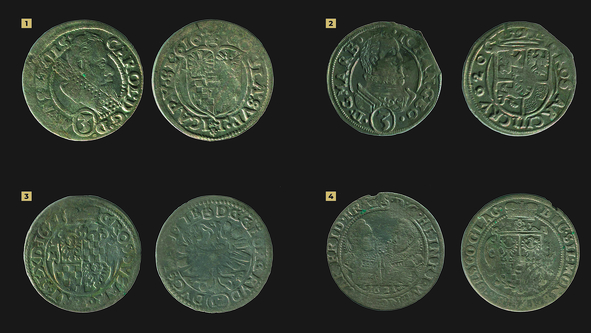FINDING TREASURE
In May 1965, one A. Mašek was carrying out excavation work at the former site of house no. 59 when he discovered a deposit of coins. The silver coins had originally been placed in a pottery vessel. Unfortunately, only a few fragments of this vessel have survived. The deposit was given to the Ostrava Museum, and it remains part of the museum’s collections to this day.

What is the treasure?
The deposit found at the site of house no. 59 consists of 228 silver coins. The oldest were minted during the reign of the Jagiellonian King Vladislaus II, and the most recent date from 1623. Almost four-fifths of the coins were minted in 1621 or 1622. The total value of the deposit was around 4000 kreutzers. For comparison: at the time, the price of a cow was just under 5000 kreutzers, 500 grams of meat cost 6 kreutzers, and a pair of shoes cost 545 kreutzers.
Who hid the treasure?
The most recent coins were minted in 1623, indicating that the treasure could have been deposited in the cellar of house no. 59 at a time when the building was owned by one Pavel Sládek, A.K.A. Jelínek. He was a wealthy burgher who also owned two more houses, one of them an inn. It is not known whether he hid the coins himself, but the composition of the deposit suggests that he may have done.
Why was the treasure hidden?
The owner of the coins may have hidden them in order to protect them from the Polish cavalry troops (Lisowczyks) who invaded the Hukvaldy estate at the end of 1623. It is not clear why their owner did not retrieve them: the owner of the house Pavel Jelínek was still alive in 1640, long after the threat from the Lisowczyks had passed.
Akce: Otevřít verzi pro tisk
